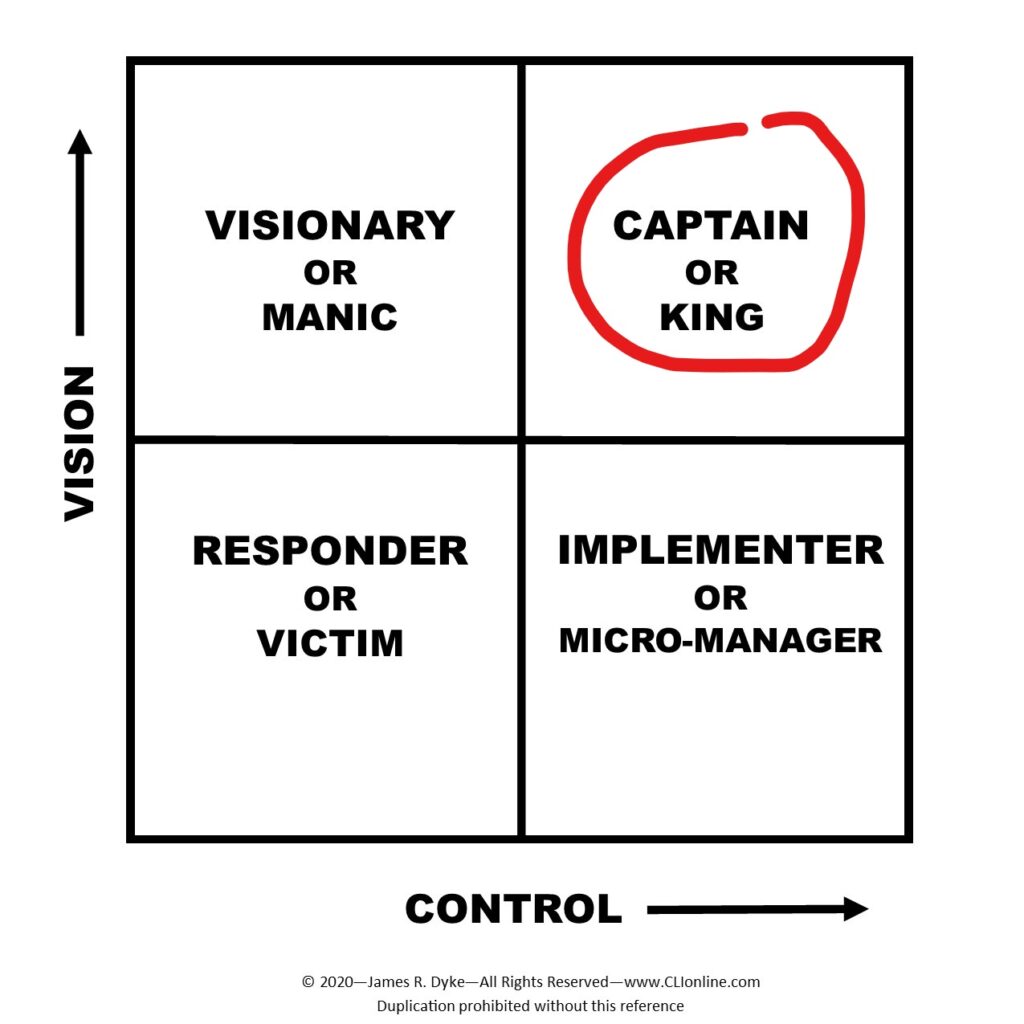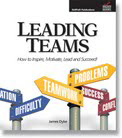High Vision and High Control

Dynamics of Effective Leadership
In my work as a leader, trainer, and executive coach I focus a great deal of my attention and learning on the dynamics of effective leadership. Many elements define leadership—things like qualities of character, behavior, skill, and temperament. In this series of blogposts, I highlight two of the most defining of these elements: vision and control. I show how these two elements identify functional and dysfunctional styles of leadership and management. More important, I reveal how each style can improve and become more effective.
Control–Monitoring and Managing
The effective leader/manager maintains an appropriate balance of both vision and control. In fact, these two elements are often used to contrast the two roles of management and leadership as distinct from one another. For example, an effective manager exercises control by monitoring the work of the team (or organization) and intervenes when problems arise to keep things functioning properly.
Vision–Steering and Innovating
An effective leader exercises vision by having a clear sense of purpose for the team (or organization). They anticipate the need for adjustment, change, problem-solving, or innovation as the team moves forward in their work and moves forward in time. Just to be clear, I will repeat what I said at the beginning: The ideal for effective leadership and management maintains an appropriate balance of both of these two elements.
Leadership Archetypes
Carl Jung is famous for his development and use of archetypes. These are models he used to identify patterns of personal behavior. As part of his system of archetypes, Jung defined “shadows” that were dysfunctional versions of each archetype. The purpose of the archetype is to help the individual identify and explore their own behavior, and address their need for growth and development. In this series, I am using the concept of archetypes for the same reason: to help leaders identify and explore their patterns of behavior and discover areas of needed growth and development.
The Captain
The first archetypes describe the leader/manager who exercises strong control and clear vision. To communicate a better understanding of what that high vision/high control balance looks like in effective leadership, I use the metaphor of a ship’s captain.
The captain of a ship has a clear destination in mind, and keeps the ship on course. In the same way, an effective leader has a clear understanding of where their team or organization is headed and how to get it there. This kind of “captain” leader has clarity about the organization’s purpose; its goals; its objectives; and its strategies. The Captain leader also makes sure the people (and their activities) are “on course” and supporting the purpose, goals, objectives, and strategies of the organization. Both the ship’s captain and The Captain leader direct a group of people who are strongly committed to the mission. And both of these individuals can also be thought of as initiators—leaders who make decisions, originate plans, give appropriate commands, and deploy their people strategically.
Supervise a Skilled Crew
The captain of a ship does not operate the entire ship by their own efforts—they supervise a skilled crew. Similarly, the effective Captain leader oversees a team of people whose combined skills and efforts collectively perform the work. Neither an effective ship’s captain nor an effective Captain Leader attempt to do the entire work of the crew or the team. Both, however, oversee the work and give appropriate direction; assess the effectiveness; address problems; and provide correction where necessary. A good ship’s captain relies on their crew to do their jobs, and avoids becoming intrusive in the details of their assignments. A good Captain leader relies on their team to do their jobs and also avoids becoming intrusive in the details of their assignments.
A good ship’s captain sees that the crew is well-trained, well-fed, well-equipped, and in some cases, well-armed! A good Captain leader exercises the same care for their team. Both treat their people fairly, and both build strong bonds of loyalty with their followers. Both maintain continuous two-way communication with their people—disseminating important information, but also relying on their subordinates for helpful feedback and input.
The King
I call the dysfunctional “shadow” of high control/high vision “The King.”
The King has clear vision, but their vision is centered primarily on themselves—how they might benefit, rise in power, increase influence, in effect—build their kingdom. The King’s subjects do not serve some collective vision for the kingdom. Their purpose is to serve the King and ensure the King’s vision and well-being. There may be other parts of the vision that are more inclusive, such as building a prosperous kingdom that benefits the subjects, as well. But those parts are incidental to the more important central vision of magnifying the King. I should emphasize that the King imposes this vision on their subjects—there is no interaction, discussion, or debate involved.
Leadership by Coercion
This imposition is an example of another aspect of the King’s leadership—it is enforced by authority and coercion. Followership is demanded on the basis of duty and status in the kingdom (e.g. the King is on the top of the org chart!). And the King is not adverse to exercising this authority by interfering with the work of their subjects—over-riding their authority; second-guessing their decisions; rejecting their ideas; taking charge of their people; and replacing their priorities with royal demands. Disagreeing with The King is not recommended—it is usually seen as the mark of disloyalty, and can lead to the withdrawal of The King’s favor and support!
Type “A” and Driven
The dysfunctional leader who exhibits the qualities of The King is typically sharply-focused, driven, self-serving, autocratic, demanding, domineering, forceful, insistent, intrusive, and often aggressive in tone and behavior. This kind of leader demands loyalty instead of earning it, and is often slow to recognize (and value) the contribution of others.
The King leader often survives in organizations because they are results-driven and often achieve their goals—albeit through sheer determination and drive. Ultimately, though—especially at higher levels in the organization—they tend to lose the goodwill and support of their subordinates, their colleagues, and their superiors.
Human resource managers are quite acquainted with this type of leader, because The King leader is likely to generate more than their share of employee complaints! Eventually, this leader is no longer welcome in the organization. More often than not, they are simply terminated. And this means another cost for the organization–the loss of The King’s skills and experience and any investment made in their employment. As a result…
Executive Coaching
King leaders are often assigned to me for executive coaching, which is probably one of the best ways for organizations to help them improve. Executive coaching offers the possibility of a positive result (if the leader is open and teachable) because the coach operates as an independent and confidential source of help and guidance. I find many of these hard-driving leaders to be open to my suggestions, because I have no authority over them and they have nothing to prove to me. They come to see me as a helpful supporter, not as a threat.
Executive coaching can be of incredible help because it has the potential to be highly individualized, highly personal, and highly focused on the executive’s specific issues and needs.
As you consider this information:
- Do the descriptions of each archetype bring to mind any managers you have seen or dealt with in your experience?
- Are any of the descriptions uncomfortably applicable to your own management style?
- Might the suggestions for improvement be helpful to your growth and development?
- Would it be useful to share this information with leaders you are managing?
Leaders like The Captain are often as rare as they are desirable. But any person with a teachable mindset can learn and apply the skills of a good Captain leader. If you or your organization has the vision for equipping leaders with better tools and insights, call us—we can help!
Until next time—yours for better leaders and better organizations!
Dr. Jim Dyke – “The Boss Doctor” ™ – Helping you to be a better boss and to have a better boss!


